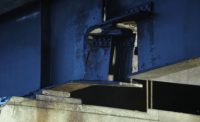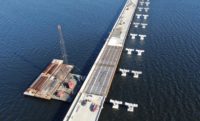The effort to clear wreckage from the collapsed Francis Scott Key in Baltimore passed a key milestone the morning of April 25 with the opening of a temporary, 300-ft wide, 35-ft deep navigation channel to facilitate marine traffic. Salvage operations continue, while Maryland officials prepare for the rebuilding process that is set to use progressive design-build project delivery.
Located to the north of the grounded container vessel Dali, which collided with the bridge on March 26, the new Patapsco River channel will provide closely managed one-way passage into and out of the Port of Baltimore. A Panama-flagged bulk carrier, one of several large vessels trapped in the port since the collapse, was the first to use the new channel, guided at each end by tugboats as it made its way toward the Chesapeake Bay.
According to the multi-agency unified command overseeing the collapse response, four of the other stranded deep-draft vessels are expected to transit the temporary channel in the coming days, along with some smaller deep-draft vessels. The new channel complements three previously established shallow-draft channels, which officials say have been used by approximately 145 vessels over the past month.
Plans call for traffic through the new temporary channel to be suspended for approximately 10 days beginning Monday April 29, so that salvors can perform rigging operations in preparation for removing the massive 5,000-ton section of bridge wreckage that now rests on the Dali’s bow.
Once the section is removed, unified command expects the Dali to be refloated and towed back to port.
“That will allow us to most effectively use the 35-foot channel, and we’ll continue to make progress on clearing the remainder of the channel,” U.S. Coast Guard Admiral Shannon Gilreath told a press briefing earlier in the week.
Unified command has targeted the end of May for fully reopening the entire 700-ft-wide, 50-ft deep draft federal channel, which is maintained by the U.S. Army Corps of Engineers, and restore normal operations to the Port of Baltimore.
Col. Estee Pinchasin, commander of the Corps’ Baltimore District, said opening the temporary channel a little more than four weeks after the collision is a credit to the efforts of unified command’s salvage contractors, including clearing “a mangled contortion of wreckage” that had been wrapped around the remains of a bridge pylon to the north of the Dali.
Despite the extreme complexity and hazards associated with the salvors’ work in an “unforgiving operational environment,” Col. Pinchasin added, “they did that with such discipline—that’s what’s going to enable us to keep moving forward and open that 50-foot channel.”
Col. Pinchasin added that salvors remain vigilant for the remains of two construction workers still missing since the collision, which occurred after the Dali appeared to experience a sudden loss of power—an area of focus for separate probes by the National Transportation Safety Board and Federal Bureau of Investigation. Though results of these investigations likely won’t be known for several months, the City of Baltimore has filed suit against the Dali’s owner, Grace Ocean Private, Ltd., and its operator, Synergy Marine Group, claiming criminal negligence for allowing the ship to leave port despite known problems with the systems, and the collision’s resulting effect on the city’s maritime economy.
Grace Ocean and Synergy have petitioned a federal court in Maryland to limit their liability to approximately $43.5 million—the value of the vessel and its cargo less salvage costs—in accordance with maritime law.
Rebuilding and Relief Plans
The Maryland Transportation Authority plans to issue a Request for Proposals for rebuilding the Key Bridge using progressive design-build project delivery. The agency has scheduled a May 7 virtual meeting with potential consultants, contractors and subcontractors to help inform the pending RFP. Information on how to become Maryland Disadvantaged Business Enterprise (DBE)-certified for this federal contracting opportunity will be provided during the forum. The RFP is expected to be released by the end of May.
Over the past weeks, state and local officials of both parties have been lobbying members of Congress to follow through on President Biden’s pledge to provide full federal funding for the new crossing.
Members of the state congressional delegation introduced on April 11 S. 4114, the Baltimore BRIDGE Relief Act, which would amend the federal cost-share requirement for Federal Highway Administration (FHWA) Emergency Relief Program for Disaster-Damaged Highways and Bridges. Emergency relief funding automatically has a 100% federal cost share for the first 270 days after the disaster, according to a release from Sen. Chris Van Hollen (D-Md.).





Post a comment to this article
Report Abusive Comment